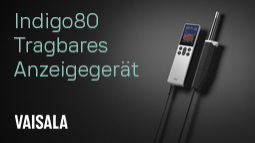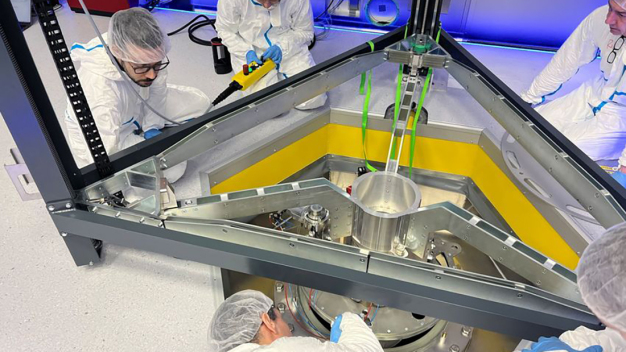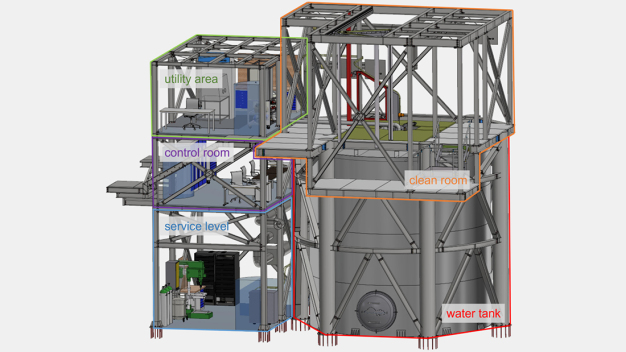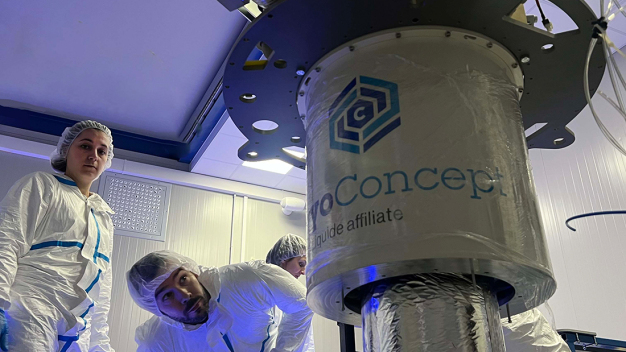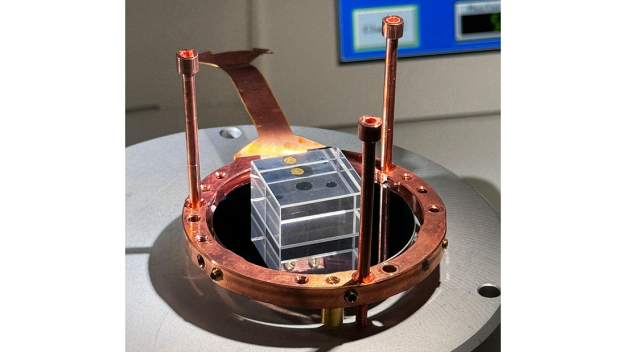- Science
COSINUS: New experiment tests controversial dark matter signals
On April 18, 2024, a large-scale experiment to detect dark matter was inaugurated in Italy. COSINUS is an international research project in which a team from the Max Planck Institute for Physics (MPP) is also involved.
The nature of dark matter is still one of the great questions of modern physics. According to current knowledge, invisible dark matter accounts for 85 percent of the total mass in the universe. The COSINUS* experiment goes into operation today at the Italian INFN Gran Sasso National Laboratory. The research project is intended to test whether another experiment (DAMA/LIBRA) has actually measured signals of dark matter - or not. COSINUS is a collaboration between the Vienna University of Technology, the Institute for High Energy Physics of the Austrian Academy of Sciences, the National Institute of Nuclear Physics (Italy), the Helsinki Institute of Physics (Finland) and the MPP.
The nature of dark matter is still one of the great questions of modern physics. According to current knowledge, invisible dark matter accounts for 85 percent of the total mass in the universe. The COSINUS* experiment goes into operation today at the Italian INFN Gran Sasso National Laboratory. The research project is intended to test whether another experiment (DAMA/LIBRA) has actually measured signals of dark matter - or not. COSINUS is a collaboration between the Vienna University of Technology, the Institute for High Energy Physics of the Austrian Academy of Sciences, the National Institute of Nuclear Physics (Italy), the Helsinki Institute of Physics (Finland) and the MPP.
For the COSINUS project, a specialized instrument has been developed in which a crystal is cooled to extremely low temperatures to measure the energy of particles accurately. If the universe is indeed filled with dark matter consisting of previously unknown particles, then Earth should collide with these particles as it moves through space, and the instrument could detect these collisions.
The DAMA/LIBRA experiment has collected data that is consistent with this assumption, although it is controversial as it has not yet been confirmed by another experiment.
Is the Earth plowing through a nebula of dark matter?
If dark matter could actually be detected, the measurements would vary throughout the year. Why? The sun and all its planets - including the earth - move around the center of the Milky Way at a speed of around 220 kilometers per second. The Earth, on the other hand, orbits the sun at a speed of around 30 kilometers per second, taking one year to complete a full orbit. This means that the Earth moves in the same direction as the sun for half a year and in the opposite direction for the other six months.
"If our galaxy is permeated by particles of dark matter, the Earth would move through this 'fog' sometimes faster, sometimes slower," explains MPP scientist Karoline Schäffner, technical director of COSINUS. "The situation is like driving a car in the rain: The faster we drive, the more raindrops hit the windshield. So, we expect to detect different amounts of dark matter at different times."
This is exactly what the DAMA/LIBRA experiment, which has been running since 1995, has shown: A signal was actually detected whose intensity changed regularly over the course of the year - an indication of dark matter. However, other experiments were unable to repeat these results.
The lack of evidence from other experiments has kept the international research community busy for years. "Our new project gives us the chance to solve this puzzle," says Karoline Schäffner. "We are using sodium iodide in our detector, the same material as in the DAMA/LIBRA experiment, in order to be able to compare the results. However, our experimental setup will achieve significantly higher accuracy."
Heat and light
The DAMA/LIBRA experiment only measures light, not heat. There are already two other experiments with which scientists are working to reproduce the DAMA/LIBRA experiments. Like the original, both only record light - unlike COSINUS, which is designed for two different signals.
At the heart of COSINUS is a cryostat - a kind of refrigerator for extremely low temperatures - in which a crystal of sodium iodide can be cooled to 1-2 hundredths of a degree above absolute zero (- 273 degrees Celsius). If this crystal is hit by dark matter particles, two reactions occur in the detector: Firstly, the atoms of the crystal are set into vibration - the crystal lattice begins to wobble and heats up. The heat energy absorbed in the process can be measured extremely accurately. Secondly, light is also produced in the crystal, which COSINUS can also "see".
Known or unknown particles?
The investigation of two signals also provides clues as to which particles are involved. "This is important because not every signal that is measured in such a detector is an indication of dark matter," explains Karoline Schäffner: "For example, it could be ordinary electrons that are produced by natural radioactivity. Or neutrons produced by cosmic particles."
In order to detect dark matter signals, the researchers have to shield the crystal as effectively as possible from any background noise. This is why the experiment is well protected in a mountain massif, in the largest underground laboratory in the world: the Gran Sasso National Laboratory (Italy), around one hundred kilometers from Rome. Under 1,400 meters of rock, a tunnel system provides space for a large number of highly sensitive experiments - the DAMA/LIBRA experiment is also set up there. The detectors are also placed in a seven-metre-high tank of ultra-pure water.
The COSINUS project will open in the Gran Sasso National Laboratory on April 18, 2024. The first results of the measurements are expected in 2025/26.
* Cryogenic Observatory for SIgnatures seen in Next-generation Underground Searches
Max-Planck-Institut für Physik
85748 Garching
Germany



